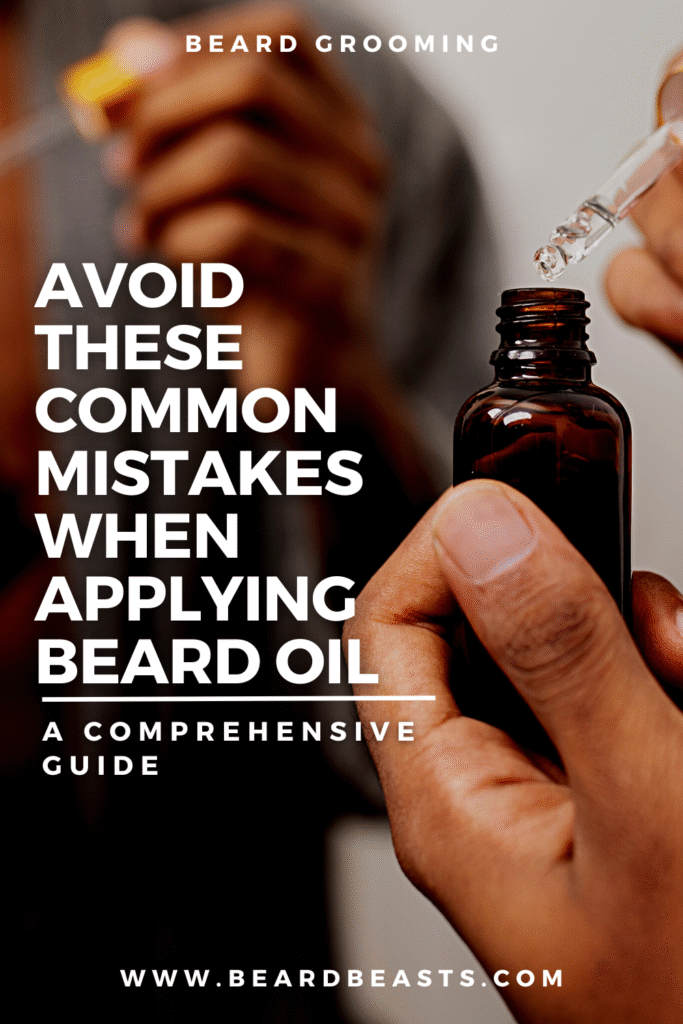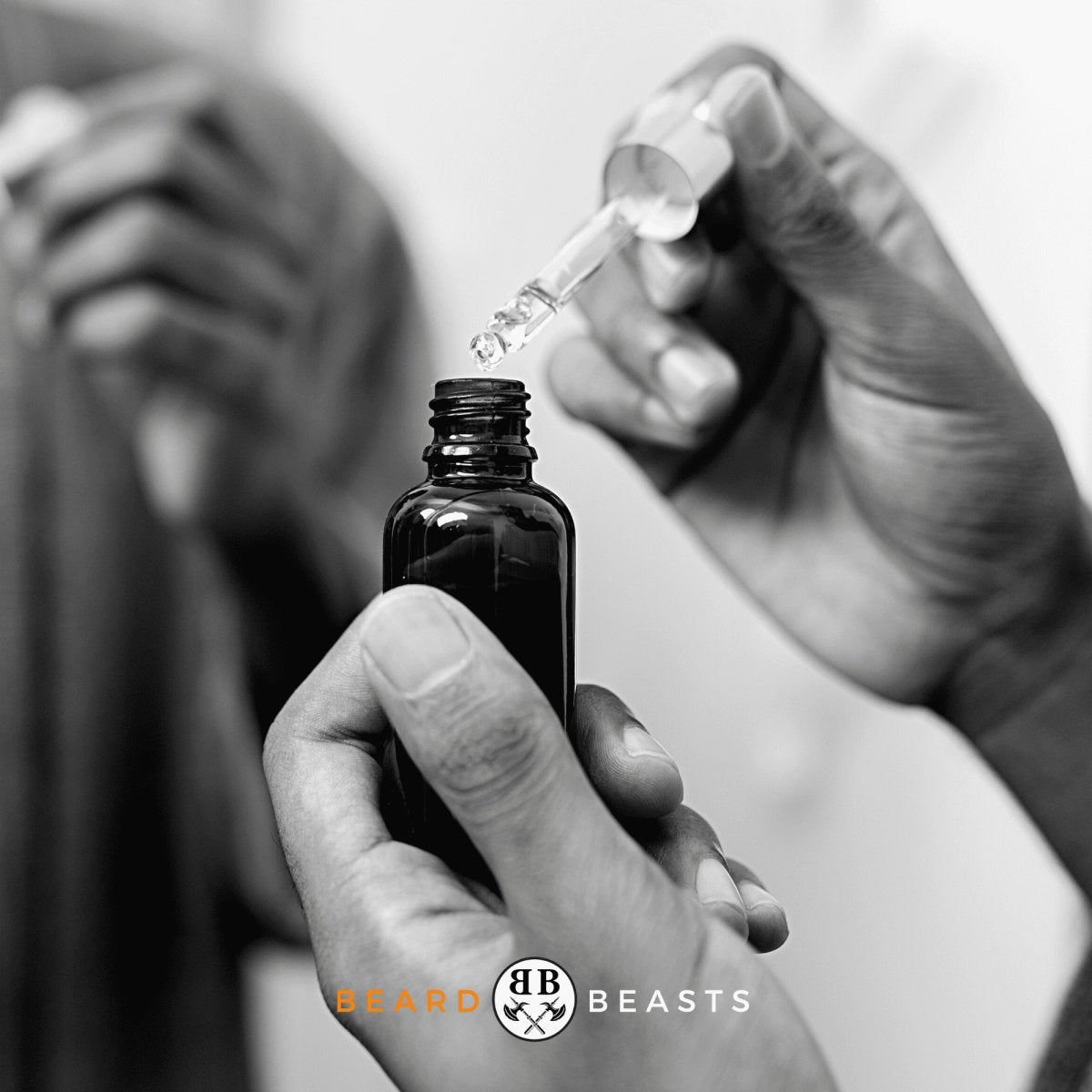Surprisingly, applying beard oil isn’t as simple as it may seem. You can’t just slather it on and expect your beard to look like it’s been groomed by the gods. The art of beard oil application is often riddled with mistakes that can lead to less than optimal results.
Using too much or too little, applying to an improperly cleansed beard, neglecting the skin underneath, or simply rushing through the process—these are just a few of the pitfalls on the path to achieving your best beard. Fortunately, by understanding and avoiding these common errors, you can ensure your beard reaps the full benefits of your beard oil.
So, whether you’re new to the beard oil game or have been playing for a while, this comprehensive guide will help you navigate these common mistakes and teach you the right way to apply beard oil, leading to a healthier, more handsome beard. Let’s get started!
Understanding Beard Oil: Ingredients and Benefits
Just like a skilful chef combines various ingredients to create a masterpiece, beard brands like ourselves use a blend of natural oils and other components to craft the perfect beard oil. So, what exactly are these magical ingredients?
The cornerstone of any quality beard oil is its carrier oils. Carrier oils, such as jojoba, argan, coconut, or sweet almond, constitute the majority of any beard oil blend. They’re called ‘carrier’ because they deliver the essential oils to your skin and hair, and they’re mild enough to use directly on the skin.
In addition to carrier oils, beard oils also contain essential oils. These potent plant extracts are responsible for the unique scents and additional health benefits.
Essential oils like tea tree, cedarwood, sandalwood, or lavender, among others, impart distinctive fragrances while providing additional antibacterial, anti-inflammatory, or soothing properties.
Lastly, some beard oils like our Hydrating Beard Oil may include Vitamin E, which is known for its antioxidant properties and its ability to promote healthy hair growth.
The Benefits of Using Beard Oil: It’s More than Just Hydration!
When it comes to the benefits of beard oil, most people tend to focus on hydration—and rightly so. Beard oil is a hydration powerhouse, keeping both your facial hair and the skin beneath moisturized. But it’s not just a one-trick pony; the benefits extend far beyond hydration.
Taming and Softening: Beard hair is typically coarser than scalp hair, making it more challenging to manage. Regular application of beard oil can soften your beard, making it feel more comfortable against your skin and easier to style.
Prevents Itchiness and Beardruff: Dry skin under your beard can lead to itchiness and even beardruff (the facial hair equivalent of dandruff). By moisturizing the skin, beard oil helps to prevent these discomforts.
Promotes Healthy Beard Growth: The nourishing ingredients in beard oil can help stimulate better beard growth, leading to a fuller, denser beard over time.
Scented for Freshness: The essential oils in beard oil also provide a pleasant scent, which can help keep your beard smelling fresh throughout the day.
Clearly, beard oil is a multi-functional product that deserves a prominent place in your grooming kit. But it’s equally essential to understand how to use it properly to reap these benefits fully.
In the next section, we’ll delve into the most common mistakes people make when applying beard oil and how to avoid them. Stay tuned!
Top Mistakes You’re Probably Making When Applying Beard Oil
Navigating the world of beard grooming can seem daunting, especially with various products, techniques, and tips flooding the internet. And when it comes to applying beard oil, there’s more to it than meets the eye.
Here’s an in-depth look at common missteps men often make when applying beard oil, robbing their beards of reaching their full potential.
Not Cleaning Your Beard Properly Before Application
Think of your beard as a forest. Over time, it can accumulate tiny particles like dust, food remnants, dead skin cells, and other debris—much like leaves falling and decaying on a forest floor. Applying beard oil to an unclean beard is akin to overlooking this natural litter, resulting in less-than-optimal results.
The grime and dirt that pile up on your beard and skin throughout the day can block the oil’s pathway, preventing it from getting where it needs to be.
Furthermore, this layer of debris can mix with the oil, reducing its effectiveness and potentially causing irritations or breakouts.
Therefore, it’s crucial to ensure your beard is thoroughly clean before the application. Using a high-quality beard wash or mild soap can cleanse your beard without stripping it of its natural oils.
For a more thorough clean, consider using a beard brush to exfoliate the skin and remove any stubborn debris.
Applying Beard Oil on a Completely Dry Beard
While it’s imperative to have a clean beard before application, applying oil on a completely dry beard can also be counterproductive.
The secret lies in understanding that beard oil is not a moisturizer but a sealant—it helps lock in moisture rather than provide it.
When applied to a bone-dry beard, the oil doesn’t have any moisture to seal in, rendering it less effective.
Conversely, applying beard oil to a damp beard—preferably after a warm shower when your skin’s pores are open and your beard is clean—allows the oil to trap water molecules against your hair and skin, providing deeper and more lasting hydration.
Using the Wrong Quantity of Beard Oil
When applying beard oil, moderation is key. Many beard enthusiasts make the mistake of using too much oil, resulting in a greasy beard that feels heavy and looks shiny.
This overuse can also lead to clogged pores, pimples, or even beard dandruff due to excessive oiliness. On the other hand, using too little beard oil defeats its purpose, as it won’t provide sufficient coverage and hydration.
The ‘right’ amount varies based on several factors like the length, thickness, and dryness of your beard. However, a few drops are usually enough for most beards. If you’re unsure, start with a small amount and gradually add more until your beard feels adequately moisturized but not overly greasy.
Ignoring the Skin Underneath Your Beard
Beard oil isn’t just for your facial hair—it also caters to the skin beneath, which is often overlooked during the application. Ignoring this can result in dry, itchy skin, and in severe cases, a condition known as ‘beardruff’, which is similar to dandruff.
When you apply beard oil, make sure to massage it deep into the skin beneath your beard. This process not only moisturizes the skin but also nourishes the hair follicles, promoting faster beard growth and reducing itchiness and flaking.
Not Massaging the Beard Oil In
If you’re applying beard oil as a splash-and-go process, you’re doing it wrong. Merely applying the oil without massaging it in can result in uneven distribution, leaving some areas parched while others are dripping with oil. A thorough massage helps ensure every strand of hair and every bit of skin gets its share of the nourishing oil.
Moreover, massaging your beard and skin stimulates blood flow, which is beneficial for your hair follicles. This increased circulation brings more nutrients to the hair roots, promoting healthier and potentially faster growth. So, don’t just apply your beard oil—massage it in for maximum benefits.
Rushing Through the Process: Patience is Key
In today’s fast-paced world, we often want quick results. But when it comes to beard grooming—and especially the application of beard oil—patience is a virtue. Rushing through the application process can result in sloppy coverage and missed spots, and hasty expectations can lead to disappointment when the desired results don’t manifest overnight.
Applying beard oil should be a ritual—a few moments of self-care in your busy day. Take your time to massage the oil thoroughly, ensuring that every hair and all your skin get coated. Be patient with the results as well. Consistent and proper use of beard oil over weeks—even months—can transform your beard from a dry, unruly mess to a soft, manageable, and healthy beard that’s truly a sight to behold.
By understanding and avoiding these common mistakes, you can ensure your beard reaps the full benefits of your nutrient-rich beard oil, leading to a healthier, better-looking beard.
Correct Ways to Apply Beard Oil: A Step-by-Step Guide
Now that we’ve tackled the common missteps, it’s time to navigate the path of correct application, enhancing your beard care regimen and allowing you to experience the full benefits of your beard oil. Below is a detailed, step-by-step guide to correctly applying beard oil.
Proper Cleansing of Your Beard
Like any art form, a great beard grooming routine begins with a clean canvas. In this case, your canvas is your beard. Begin by washing your beard with a gentle beard shampoo or soap, free of harsh chemicals that can strip away natural oils. Using warm water can help open up your pores, ensuring a more thorough cleanse.
After washing, towel-dry your beard but leave it slightly damp. Remember, you want to trap some moisture in your beard when you apply the oil. It’s also a good idea to use a beard brush or comb to remove any tangled hair and dislodge any stubborn dirt or dead skin cells.
When and How Much Beard Oil to Use
The best time to apply beard oil is just after a shower when your beard is clean, your pores are open, and your hair is slightly damp. The heat and steam from the shower help open up your pores, increasing the absorption of the oil.
When it comes to how much oil to use, remember the golden rule of moderation. For most beards, 3-6 drops should suffice. However, if you have a shorter beard, 1-2 drops might be enough, while those with longer or thicker beards may need more. Start small, and adjust based on your beard’s needs.
The Right Way to Massage Beard Oil In
Pour the required amount of beard oil into your palm, rub your hands together to distribute it evenly, and then apply it to your beard. Start from the roots and work your way to the tips of your beard. Make sure to massage the oil deep into your beard, ensuring it reaches your skin underneath.
The massage not only ensures that the oil is evenly distributed, but it also stimulates blood circulation, promoting healthier and potentially faster beard growth. Don’t forget your moustache either—give it the same oil treatment as your beard.
Incorporating Beard Oil into Your Daily Routine
The key to a great beard is consistency. Make beard oil application a part of your daily grooming routine. Ideally, apply it once in the morning to keep your beard looking and feeling great throughout the day. If you live in a particularly dry climate or your beard tends to dry out quickly, a second application in the evening might be beneficial.
Remember, patience is a virtue when it comes to beard grooming. Don’t expect instantaneous results after one application. Over time, with consistent use, you’ll begin to notice your beard becoming softer, easier to manage, and healthier.
By following this step-by-step guide, you can sidestep the common errors in applying beard oil and enjoy the many benefits it offers. In the end, mastering the art of beard oil application is about understanding your beard’s needs and catering to them with patience and consistency.
The Consequences of Misusing Beard Oil: Understanding the Risks
Despite the myriad of benefits beard oil offers, misuse can lead to unwanted consequences. This section aims to underline the importance of proper application by shedding light on the potential risks that come with misusing beard oil.
Understanding these risks will emphasize why correct application is crucial to your beard care routine.
Potential Skin Issues from Incorrect Application
While beard oil is designed to enhance the health and appearance of your beard and skin, incorrect application can cause a host of skin problems. One of the most common issues is clogged pores, which can result from applying too much oil or not cleansing your beard properly before application.
Blocked pores can lead to the development of acne and pimples, causing discomfort and negatively impacting the appearance of your beard.
Another risk is skin irritation. This can occur when you apply beard oil to unclean skin, causing dirt and debris to mix with the oil. The result can be inflammation, itching, and even dermatitis—a condition that can cause red, itchy, and flaky skin.
Furthermore, if you neglect the skin underneath your beard during application, it can become dry, leading to itchiness, flaking, and the development of ‘beardruff’.
Impact on Beard Health and Appearance
Incorrect application of beard oil can also have adverse effects on your beard’s health and appearance. For instance, applying too much oil can make your beard look greasy and unwieldy, detracting from its natural allure. On the flip side, not using enough oil can leave your beard dry, frizzy, and prone to split ends.
Moreover, failing to distribute the oil evenly by neglecting to massage it in can result in patchy areas where some parts are well-nourished, while others are parched. This can lead to an uneven beard texture and appearance.
If you rush through the application process or neglect to incorporate beard oil into your regular grooming routine, your beard may fail to achieve its full potential. It could remain dry, rough, and hard to manage.
Moreover, inconsistent use of beard oil can stunt your progress towards a healthy and attractive beard, as the benefits of beard oil are best realized through regular and proper application.
In conclusion, misusing beard oil can lead to potential skin issues and negatively impact your beard’s health and appearance. However, these risks can be avoided by following the correct application steps and incorporating them into your daily routine.
Remember, your beard is a reflection of the care you put into it, and correct beard oil application is a key element of this care.
Tips for Choosing the Right Beard Oil for Your Beard Type
Just like finding the perfect pair of jeans or your go-to coffee order, discovering the right beard oil for your specific beard type requires understanding your needs and preferences.
Not all beard oils are created equal, and what works wonders for one beard might not have the same effect on another.
Here, we delve into the different types of beard oils, considerations for selection, and recommendations for different beard types and skin sensitivities.
Understanding Different Types of Beard Oils
At the core of any beard oil are two main components: carrier oils and essential oils. Carrier oils form the base of beard oil and do most of the heavy lifting in terms of nourishing your beard and skin. Commonly used carrier oils include jojoba, argan, sweet almond, and coconut oil.
On the other hand, essential oils contribute to the scent and add extra benefits. For instance, tea tree oil has antimicrobial properties, and lavender oil is known for its calming effect. However, essential oils are potent and are usually included in smaller amounts.
Additionally, some beard oils may contain added vitamins, like Vitamin E, for additional nourishing and antioxidant properties.
Considerations When Selecting Beard Oil: Scent, Consistency, and Ingredients
When selecting beard oil, consider the scent, consistency, and ingredients. In terms of scent, some oils have a more potent fragrance than others. Depending on your preference, you might opt for a more strongly scented oil or a subtler one. Just remember that you’ll be smelling this scent throughout the day.
The consistency of the oil can also affect your experience. Some oils are heavier and may leave a slight residue, while others are lightweight and quickly absorbed.
Furthermore, the ingredients should align with your skin and hair needs. For instance, if you have dry skin, an oil with more moisturizing carrier oils like argan or coconut oil could be beneficial. Always check the ingredient list to ensure the oil doesn’t contain any allergens or irritants, especially if you have sensitive skin.
Recommendations for Different Beard Types and Skin Sensitivities
Selecting the right beard oil also depends on your beard type and skin sensitivity. For shorter beards, a lightweight oil might suffice. For longer, coarser beards, a heavier oil with deep-conditioning carrier oils like castor oil could be more beneficial.
If you have sensitive skin, look for beard oils with calming and hypoallergenic ingredients like jojoba oil and avoid those with potential irritants, such as artificial fragrances.
For oily skin, choose a lighter, non-comedogenic oil like grapeseed oil that won’t clog your pores. For dry skin, a more moisturizing oil like argan or coconut oil can help keep your skin and beard hydrated.
By understanding your beard type and skin sensitivity, and considering factors such as scent, consistency, and ingredients, you can select the right beard oil to nourish and beautify your beard. Remember, the perfect beard oil is one that meets your unique needs and preferences, contributing to a healthy and attractive beard.
FAQ: Addressing Common Questions about Applying Beard Oil
With so much information to digest, it’s natural to have questions. After all, understanding is the first step to mastery. Here, we answer some of the most frequently asked questions about applying beard oil.
Can I Apply Beard Oil Every Day?
Absolutely! Applying beard oil daily is actually recommended for most beards. Beard oil helps to moisturize your beard and the skin underneath, preventing dryness, itchiness, and flakiness. Daily application also ensures your beard remains soft, manageable, and lustrous.
However, remember to adjust based on your beard’s needs and your environment. For instance, if your beard or skin feels too oily, you might want to reduce the frequency or the quantity of oil you’re using. Conversely, if you live in a dry climate, you may find that your beard benefits from more frequent application.
How Much Beard Oil Should I Use?
The quantity of beard oil to use largely depends on the length and thickness of your beard. A good rule of thumb is to start small and adjust as needed.
For short beards, 1-2 drops might suffice. Medium beards might require 3-4 drops, while long or thick beards could need 5-7 drops, or even more. It’s best to apply a little at a time and increase as needed to avoid making your beard too greasy.
Remember, the goal is to lightly coat your beard and the skin underneath, not to saturate it. Your beard should look healthy and shiny, not oily.
Can Beard Oil Cause Skin Problems?
Beard oil, when used correctly, is designed to improve the health of your beard and skin. However, incorrect application or use of a product that doesn’t suit your skin type can lead to problems. For example, applying too much oil or not cleansing your beard before application can lead to clogged pores and potentially cause acne or pimples.
Moreover, if you’re allergic to any of the ingredients in the beard oil, it can cause skin irritation, redness, or itching. Always check the ingredient list before using a new product and consider doing a patch test to ensure you don’t react negatively to it.
Always remember, if you experience any adverse reactions or if skin problems persist, it’s best to stop using the product and consult a healthcare professional.
Through understanding and proper application, you can avoid most of these potential issues and enjoy the many benefits that beard oil offers. Your journey to a healthier, more attractive beard starts with the right knowledge and the right practices.

Conclusion: Perfecting Your Beard Care Routine
Navigating the landscape of beard care can feel like a challenging journey, but it’s one filled with rewarding discoveries. As we wrap up, let’s recap the critical points we’ve covered about common mistakes in beard oil application and the transformative impact of doing it right.
Recap of Common Beard Oil Application Mistakes
We’ve detailed the common errors that many make when applying beard oil. These include not properly cleaning your beard before application, applying the oil on a completely dry beard, using the wrong amount, ignoring the skin underneath your beard, failing to massage the oil in, and rushing through the process.
Each mistake may seem insignificant on its own, but collectively they can rob your beard of the full nourishment and benefits beard oil can provide. Awareness of these common missteps is your first step towards improving your beard care routine.
Final Thoughts: How Correct Beard Oil Application Can Transform Your Beard
When applied correctly, beard oil can truly transform your beard, turning it from a dry, unruly mess into a soft, manageable, and attractive facial feature. Beyond improving the look and feel of your beard, it nourishes the skin beneath, helping to avoid discomfort like itching or flakiness.
Correct application involves a comprehensive understanding of the process—from how to prepare your beard for oil application, the right quantity to use, how to massage it in, when to apply it, and how to make it a consistent part of your grooming routine.
Remember, every beard is unique. It’s essential to listen to your beard’s needs and respond accordingly, adjusting the quantity of oil, the frequency of application, or even the type of beard oil you use.
In conclusion, beard oil application is an art that, when mastered, brings a world of difference to your beard care routine. It’s about commitment, patience, and consistency. Keep learning, keep experimenting, and in time, you’ll discover the perfect formula for your beard. Because, at the end of the day, a well-groomed beard is not just a fashion statement—it’s a testament to your self-care and personal style.





